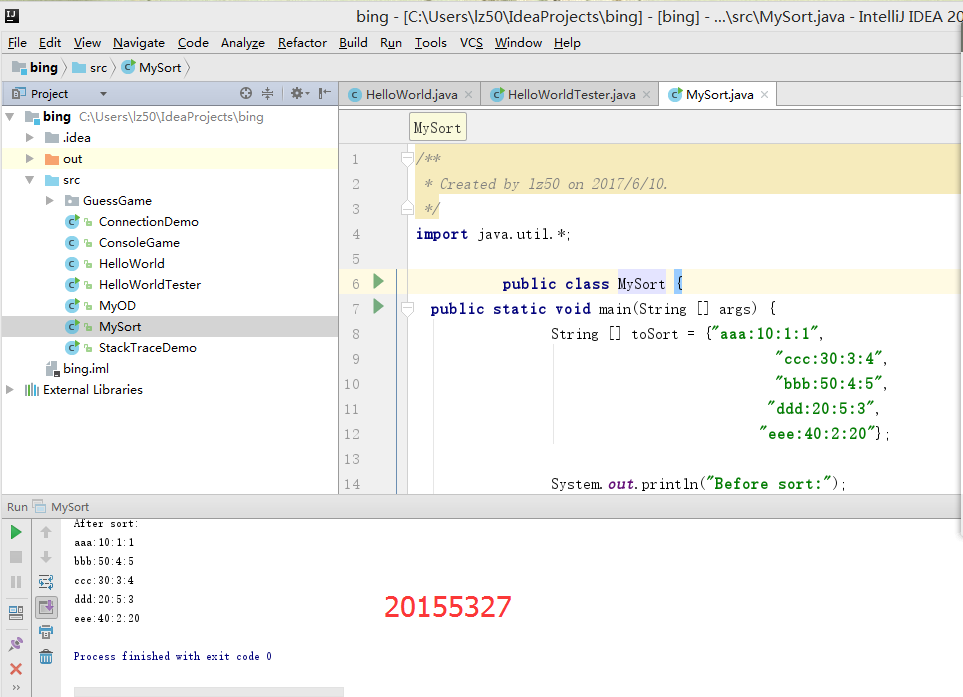第十二周测试
MySort
注意:研究sort的其他功能,要能改的动代码,需要答辩
模拟实现Linux下Sort -t : -k 2的功能。
要有伪代码,产品代码,测试代码(注意测试用例的设计)
参考 Sort的实现。提交博客链接。
1 import java.util.*;
2
3 public class MySort1 {
4 public static void main(String [] args) {
5 String [] toSort = {"aaa:10:1:1",
6 "ccc:30:3:4",
7 "bbb:50:4:5",
8 "ddd:20:5:3",
9 "eee:40:2:20"};
10
11 System.out.println("Before sort:");
12 for (String str: toSort)
13 System.out.println(str);
14
15 Arrays.sort(toSort);
16
17 System.out.println("After sort:");
18 for( String str : toSort)
19 System.out.println(str);
20 }
21 }
基础知识:
split() :把一个字符串分割成字符串数组
"2:3:4:5".split("😊 //将返回["2", "3", "4", "5"]
"hello".split("", 3) //可返回 ["h", "e", "l"]
实践代码
import java.util.*;
public class Mysort1 {
public static void main(String [] args) {
String [] toSort = {"aaa:10:1:1",
"ccc:30:3:4",
"bbb:50:4:5",
"ddd:20:5:3",
"eee:40:2:20"};
System.out.println("Before sort:");
for (String str: toSort)
System.out.println(str);
String [] s1 = new String[toSort.length];
for (int i = 0; i < toSort.length; i++) {
String list[] = toSort[i].split(":");
s1[i] = list[2];
}
Arrays.sort(s1);
String [] s2 = new String[toSort.length];
for (int i=0; i<s1.length;i++)
for (int j=0;j<toSort.length;j++)
if( toSort[j].charAt(7) == (s1[i].toCharArray()[0]))
s2[i] = toSort[j];
System.out.println("After sort:");
for(String str : s2 )
System.out.println(str);
}
}
程序截图

实践反思
1.对于转换字符串数组:调用Integer.parseInt()方法进行转换。
2.int与Integer的区别:
nteger类提供了多个方法,能在 int 类型和 String 类型之间互相转换,还提供了处理 int 类型时非常有用的其他一些常量和方法。如果需要调用Integer类的方法,查阅API文档
Arrays和String单元测试
一.实践要求
在IDEA中以TDD的方式对String类和Arrays类进行学习
测试相关方法的正常,错误和边界情况
String类
charAt
split
Arrays类
sort
binarySearch
代码
1.产品代码
public class StringBufferDemo{
StringBuffer buffer = new StringBuffer();
public StringBufferDemo(StringBuffer buffer){
this.buffer = buffer;
}
public Character charAt(int i){
return buffer.charAt(i);
}
public int capacity(){
return buffer.capacity();
}
public int length(){
return buffer.length();
}
public int indexOf(String buf) {
return buffer.indexOf(buf);
}
}
2.测试代码
import junit.framework.TestCase;
import org.junit.Test;
import static org.junit.Assert.*;
/**
* Created by Administrator on 2017/4/21 0021.
*/
public class StringBufferDemoTest extends TestCase {
StringBuffer a = new StringBuffer("StringBuffer");//测试12个字符(<=16)
StringBuffer b = new StringBuffer("StringBufferStringBuffer");//测试24个字符(>16&&<=34)
StringBuffer c = new StringBuffer("StringBufferStringBufferStringBuffer");//测试36个字符(>=34)
@Test
public void testcharAt() throws Exception{
assertEquals('S',a.charAt(0));
assertEquals('g',a.charAt(5));
assertEquals('r',a.charAt(11));
}
@Test
public void testcapacity() throws Exception{
assertEquals(28,a.capacity());
assertEquals(40,b.capacity());
assertEquals(52,c.capacity());
}
@Test
public void testlength() throws Exception{
assertEquals(12,a.length());
assertEquals(24,b.length());
assertEquals(36,c.length());
}
@Test
public void testindexOf() throws Exception{
assertEquals(0,a.indexOf("Str"));
assertEquals(5,a.indexOf("gBu"));
assertEquals(10,a.indexOf("er"));
}
}
运行结果

总结
charAt()方法是一个能够用来检索特定索引下的字符的String实例的方法,charAt()方法返回指定索引位置的字符值。索引范围为0~length()-1。
String的charAt的作用是将字符串中第i个位置上的字符(从0开始计数)赋值给n,其用法为
n=string.charAt(i)
String的split的作用是将字符串拆分成为几个字符串,其用法为(将字符串string以:为界限进行拆分,将拆分的几个字符串赋值给字符串数组string1)
string1=string.split("😊
Arrays的sort的作用是将数组中的元素从小到大排序,其用法为(对arr数组进行排序)
Arrays.sort(arr);
Arrays的binarySearch是寻找数组中某个元素所处的位置,其用法为(在arr中寻找数字1,将数字1的位置赋值给n,从0开始计数)
n=Arrays.binarySearch(arr,1);



 posted on
posted on

